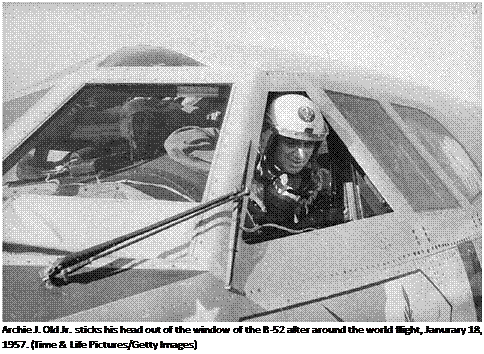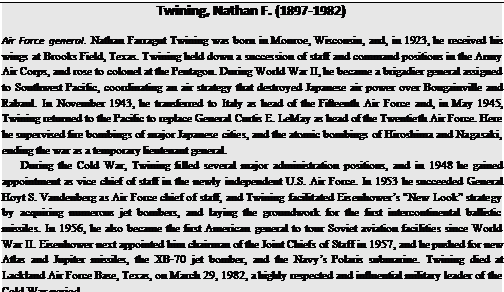1957
January 16—18 Three B-52s from the 93rd Bombardment Wing, including Lucky Lady III under mission commander Major General Archie J. Old, Jr., make the world’s first nonstop, around-the – world jet flight from Castle Air Force Base, California. The voyage covers 24,325 miles, requires five in-flight refuelings, and takes 45 hours and 19 minutes to execute. This dramatic display by the Strategic Air Command (SAC) to hit any region on the globe results in a Mackay Trophy for the unit and a Distinguished Flying Cross for each crew member.
January 25 The Air Force unsuccessfully test launches the new Thor intermediate range ballistic missile (IRBM) for the first time; the prototype had been under construction for 13 months prior to this setback.
MARCH 27 The McDonnell F-101B voodoo makes its initial flight; this is a two-seat version of the original interceptor and now carries a radar operator.
APRIL 1 The Strategic Air Command (SAC) begins transferring all of its fighter wings over to the Tactical Air Command (TAC) in order to concentrate on manned bombers and guided missiles.
 |
April 11 The Ryan X-13 Vertijet prototype becomes the first jet aircraft to take off vertically, transition to a conventional flight profile, then land vertically. However, functional vertical takeoff and landing aircraft (VTOL) are still two decades away.
April 19 At Cape Canaveral, Florida, the Douglas XSM-75 Thor missile is successfully launched, but the safety officer destroys it during the flight
May 6 The title ofDepartment ofDefense Special Assistant for Guided Missiles is conferred upon William M. Holaday.
June 2 Over Minnesota, the balloon Man High I piloted by Captain Joseph W. Kit – tinger, Jr., reaches 96,000 feet during a flight of 6 hours and 34 minutes. This constitutes a new record for balloon endurance/altitudes, and is also the first time a solo balloon has reached the stratosphere.
At Laughlin Air Force Base, Texas, the first production model U-2 spyplane deploys with the 4080th Strategic Reconnaissance Wing.
June 11 At Laughlin Air Force Base, the 4080th Strategic Reconnaissance Wing accepts its first U-2 as operational. In contrast with CIA-operated U-2s, which are painted black, Air Force vehicles retain their silver aluminum finish.
June 28 At Castle Air Force Base, California, the first operational Boeing KC – 135 Stratotanker deploys with the 93rd Air Refueling Squadron.
July 1 In Washington, D. C., General Thomas D. White gains appointment as Air Force chief of staff.
At Cooke Air Force Base, California, the first Air Force intercontinental ballistic missile base (ICMB) becomes operational. The 704th Strategic Missile Wing
 |
(SMW) located there operates the Northrop Snark, an early form of cruise missile.
The Far East Air Forces (FEAF) is redesignated the Pacific Air Command (PAC) with new headquarters at Hickam Field, Hawaii.
July 10 This day the Air Force reveals the existence of the B-58 Hustler to the American public.
July 13 In Washington, D. C., President Dwight D. Eisenhower becomes the first chief executive to fly in a helicopter when he boards an Air Force Bell UH – 13J for a meeting at an undisclosed location.
July 19 A Douglas MB-1 Genie antiaircraft missile is fired by an F-89J Scorpion for the first time. This is the first weapon ofits kind to be armed with a nuclear warhead and is intended to break up enemy bomber formations in a single blast.
July 24 The Distant Early Warning (DEW) line, which stretches across the
northernmost reaches of Canada, is declared operational.
AUGUST 15 In Washington, D. C., General Nathan F. Twining becomes the first Air Force officer to serve as chairman of the Joint Chiefs of Staff (JCS).
AUGUST 19—20 Over Crosby, Minnesota, the balloon Man High II piloted by Major David G. Simmons sets a new altitude record for this type ofcraft by reaching 101,516 feet. He remains aloft for 32 hours before finally touching down at Elm Lake, South Dakota.
September 3 The NACA report “Study of the Feasibility of a Hypersonic Research Plane” is delivered to the Air Force for its consideration. The outcome of this project is the X-15 rocket plane.
September 4 The Lockheed CL-328 Jetstar transport makes its maiden flight; it enters service as the C-140 as a test bed for navigation and communications equipment.
September 20 At Cape Canaveral, Florida, a Thor IRBM missile is successfully launched for the first time.
OCTOBER 1 At Cape Canaveral, Florida, an Air Force crew test launches a North – rop Snark intercontinental ballistic missile for the first time.
OCTOBER 4 The Space Age commences following the successful Soviet launch of Sputnik I, the world’s first artificial satellite. This event serves as a catalyst for U. S. missile programs to prevent falling further behind the Russians.
OCTOBER 20 The Air Force’s Project far side unfolds as a three-stage rocket is launched from a balloon flying 19 miles above the Earth’s surface. This flight is an attempt by the Office of Scientific Research to gather information about cosmic rays from an altitude of 4,000 miles.
OCTOBER 24 A call is made for a hypersonic glide rocket weapon system by the Air Force Research and Development Command (ARDC). The WS464L project eventually becomes the Dyna – Soar system.
NOVEMBER 7 In Washington, D. C., President Dwight D. Eisenhower appoints James R. Killian, president of the Massachusetts Institute of Technology (MIT), to serve as the first special assistant to the president for science and technology.
NOVEMBER 13 At Buenos Aires, Argentina, a Boeing KC-135 Stratotanker flown by Air Force Vice Chief of Staff Curtis E. LeMay arrives after traveling 6,350 miles in a new nonstop distance record. His return trip proves equally laudable, reducing his flying time to a record 11 hours and 5 minutes; LeMay wins a Distinguished Flying Cross.
NOVEMBER 21 The Air Force selects
Warren Air Force Base, Wyoming, as the site for its first dedicated ICBM base.
Retired general James H. “Jimmy” Doolittle heads up a new committee exploring the challenges of space travel for the NACA.
November 27 RF-101C Voodoos of
the 363rd Tactical Reconnaissance Wing complete Operation sun run, whereby three existing transcontinental speed records are broken by refueling with KC-135 Stratotankers at high altitude.
In Washington, D. C., the Defense Department authorizes production of the Thor and Jupiter intermediate range ballistic missiles (IRBMs), which will be deployed with the Air Force.
November 29 In Washington, D. C.,
Air Force Chief of Staff Thomas D. White assigns intercontinental and intermediate range ballistic missiles to the Strategic Air Command (SAC).
DECEMBER 12 Over Edwards Air Force Base, California, a McDonnell F-101A Voodoo flown by Major Adrian Drew sets a new speed record of 1,207.6 miles per hour.
December 15 At Patrick Air Force Base, Florida, the 556th Strategic Missile Squadron becomes the first operational unit equipped with Northrop SM-62 Snark missiles.
December 17 The first Atlas intercontinental ballistic missile (ICBM) is successfully launched and delivers its nose cone capsule 500 miles downrange as predicted. This is a major step in perfecting these strategic weapons.
December 19 A Thor IRBM makes a successful fourth test flight, this time being fully guided by an all-inertial guidance system.
December 23 The Air Force contracts with North American Aircraft to design
and construction a prototype Mach 3 strategic bomber, which becomes the XB-70 Valkyrie.










